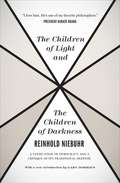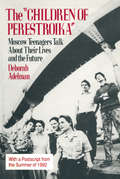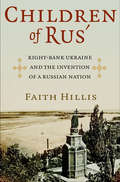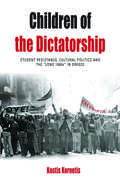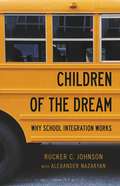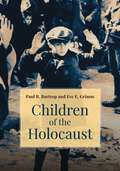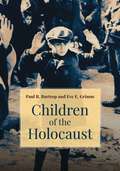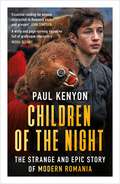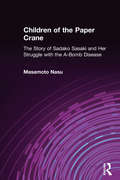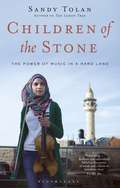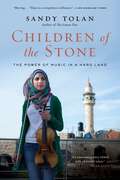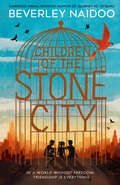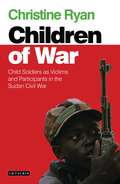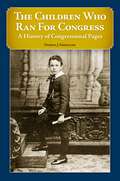- Table View
- List View
The Children of Light and the Children of Darkness: A Vindication of Democracy and a Critique of Its Traditional Defense
by Reinhold NiebuhrThe Children of Light and the Children of Darkness, first published in 1944, is considered one of the most profound and relevant works by the influential theologian Reinhold Niebuhr, and certainly the fullest statement of his political philosophy. Written and first read during the prolonged, tragic world war between totalitarian and democratic forces, Niebuhr’s book took up the timely question of how democracy as a political system could best be defended. Most proponents of democracy, Niebuhr claimed, were “children of light,” who had optimistic but naïve ideas about how society could be rid of evil and governed by enlightened reason. They needed, he believed, to absorb some of the wisdom and strength of the “children of darkness,” whose ruthless cynicism and corrupt, anti-democratic politics should otherwise be repudiated. He argued for a prudent, liberal understanding of human society that took the measure of every group’s self-interest and was chastened by a realistic understanding of the limits of power. It is in the foreword to this book that he wrote, “Man’s capacity for justice makes democracy possible; but man’s inclination to injustice makes democracy necessary.” This edition includes a new introduction by the theologian and Niebuhr scholar Gary Dorrien in which he elucidates the work’s significance and places it firmly into the arc of Niebuhr’s career.
The Children of Light and the Children of Darkness: A Vindication of Democracy and a Critique of Its Traditional Defense
by Reinhold NiebuhrThe Children of Light and the Children of Darkness, first published in 1944, is considered one of the most profound and relevant works by the influential theologian Reinhold Niebuhr, and certainly the fullest statement of his political philosophy. Written and first read during the prolonged, tragic world war between totalitarian and democratic forces, Niebuhr’s book took up the timely question of how democracy as a political system could best be defended. Most proponents of democracy, Niebuhr claimed, were “children of light,” who had optimistic but naïve ideas about how society could be rid of evil and governed by enlightened reason. They needed, he believed, to absorb some of the wisdom and strength of the “children of darkness,” whose ruthless cynicism and corrupt, anti-democratic politics should otherwise be repudiated. He argued for a prudent, liberal understanding of human society that took the measure of every group’s self-interest and was chastened by a realistic understanding of the limits of power. It is in the foreword to this book that he wrote, “Man’s capacity for justice makes democracy possible; but man’s inclination to injustice makes democracy necessary.” This edition includes a new introduction by the theologian and Niebuhr scholar Gary Dorrien in which he elucidates the work’s significance and places it firmly into the arc of Niebuhr’s career.
The Children of Light and the Children of Darkness: A Vindication of Democracy and a Critique of Its Traditional Defense
by Reinhold NiebuhrThe Children of Light and the Children of Darkness, first published in 1944, is considered one of the most profound and relevant works by the influential theologian Reinhold Niebuhr, and certainly the fullest statement of his political philosophy. Written and first read during the prolonged, tragic world war between totalitarian and democratic forces, Niebuhr’s book took up the timely question of how democracy as a political system could best be defended. Most proponents of democracy, Niebuhr claimed, were “children of light,” who had optimistic but naïve ideas about how society could be rid of evil and governed by enlightened reason. They needed, he believed, to absorb some of the wisdom and strength of the “children of darkness,” whose ruthless cynicism and corrupt, anti-democratic politics should otherwise be repudiated. He argued for a prudent, liberal understanding of human society that took the measure of every group’s self-interest and was chastened by a realistic understanding of the limits of power. It is in the foreword to this book that he wrote, “Man’s capacity for justice makes democracy possible; but man’s inclination to injustice makes democracy necessary.” This edition includes a new introduction by the theologian and Niebuhr scholar Gary Dorrien in which he elucidates the work’s significance and places it firmly into the arc of Niebuhr’s career.
The Children of Light and the Children of Darkness: A Vindication of Democracy and a Critique of Its Traditional Defense
by Reinhold NiebuhrThe Children of Light and the Children of Darkness, first published in 1944, is considered one of the most profound and relevant works by the influential theologian Reinhold Niebuhr, and certainly the fullest statement of his political philosophy. Written and first read during the prolonged, tragic world war between totalitarian and democratic forces, Niebuhr’s book took up the timely question of how democracy as a political system could best be defended. Most proponents of democracy, Niebuhr claimed, were “children of light,” who had optimistic but naïve ideas about how society could be rid of evil and governed by enlightened reason. They needed, he believed, to absorb some of the wisdom and strength of the “children of darkness,” whose ruthless cynicism and corrupt, anti-democratic politics should otherwise be repudiated. He argued for a prudent, liberal understanding of human society that took the measure of every group’s self-interest and was chastened by a realistic understanding of the limits of power. It is in the foreword to this book that he wrote, “Man’s capacity for justice makes democracy possible; but man’s inclination to injustice makes democracy necessary.” This edition includes a new introduction by the theologian and Niebuhr scholar Gary Dorrien in which he elucidates the work’s significance and places it firmly into the arc of Niebuhr’s career.
Children of Other Worlds: Exploitation in the Global Market
by Jeremy SeabrookMore than 40,000 children die daily in the developing world from avoidable sickness and disease. Tens of millions of children labour in mines, mills and sweatshops, or scavenge for a living on city streets and dumps. In the so-called developed world, children's lives are similarly blighted by drugs, alcohol, sexual abuse and violence. *BR**BR*Children of the rich are unhealthily obsessed with consumerist desires while children of the poor suffer from lack of opportunity. The global market is responsible for both of these ills.*BR**BR*In Children of Other Worlds Jeremy Seabrook examines the international exploitation of children and exposes the hypocrisy, piety and moral blindness that have informed so much of the debate in the West on the rights of the child. Seabrook insists that the whole question of protecting children's rights must take into consideration the structural abuses of humanity that are inherent in globalisation.
The Children of Perestroika: Moscow Teenagers Talk About Their Lives and the Future
by Deborah AdelmanThis work provides an examination of US refugee policy since the 1960s, particularly as it has been applied to Cuba, Haiti and Central America. The authors also address world-wide refugee problems, proposing ideas for the 21st century.
The Children of Perestroika: Moscow Teenagers Talk About Their Lives and the Future
by Deborah AdelmanThis work provides an examination of US refugee policy since the 1960s, particularly as it has been applied to Cuba, Haiti and Central America. The authors also address world-wide refugee problems, proposing ideas for the 21st century.
The Children of Perestroika Come of Age: Young People of Moscow Talk About Life in the New Russia
by Deborah AdelmanDemonstrates the relevance, rigor, and creativity of interpretive research methodologies for political science and its various sub-fields. Designed for use in a course on interpretive research methods, this book situates methods questions within the context of methodological questions - the character of social realities and their "know-ability."
The Children of Perestroika Come of Age: Young People of Moscow Talk About Life in the New Russia
by Deborah AdelmanDemonstrates the relevance, rigor, and creativity of interpretive research methodologies for political science and its various sub-fields. Designed for use in a course on interpretive research methods, this book situates methods questions within the context of methodological questions - the character of social realities and their "know-ability."
Children of Rus': Right-Bank Ukraine and the Invention of a Russian Nation
by Faith HillisIn Children of Rus’, Faith Hillis recovers an all but forgotten chapter in the history of the tsarist empire and its southwestern borderlands. The right bank, or west side, of the Dnieper River—which today is located at the heart of the independent state of Ukraine—was one of the Russian empire’s last territorial acquisitions, annexed only in the late eighteenth century. Yet over the course of the long nineteenth century, this newly acquired region nearly a thousand miles from Moscow and St. Petersburg generated a powerful Russian nationalist movement. Claiming to restore the ancient customs of the East Slavs, the southwest’s Russian nationalists sought to empower the ordinary Orthodox residents of the borderlands and to diminish the influence of their non-Orthodox minorities. Right-bank Ukraine would seem unlikely terrain to nourish a Russian nationalist imagination. It was among the empire’s most diverse corners, with few of its residents speaking Russian as their native language or identifying with the culture of the Great Russian interior. Nevertheless, as Hillis shows, by the late nineteenth century, Russian nationalists had established a strong foothold in the southwest’s culture and educated society; in the first decade of the twentieth, they secured a leading role in local mass politics. By 1910, with help from sympathetic officials in St. Petersburg, right-bank activists expanded their sights beyond the borderlands, hoping to spread their nationalizing agenda across the empire.Exploring why and how the empire’s southwestern borderlands produced its most organized and politically successful Russian nationalist movement, Hillis puts forth a bold new interpretation of state-society relations under tsarism as she reconstructs the role that a peripheral region played in attempting to define the essential characteristics of the Russian people and their state.
Children of the Dictatorship: Student Resistance, Cultural Politics and the 'Long 1960s' in Greece (Protest, Culture & Society #10)
by Kostis KornetisPutting Greece back on the cultural and political map of the “Long 1960s,” this book traces the dissent and activism of anti-regime students during the dictatorship of the Colonels (1967-74). It explores the cultural as well as ideological protest of Greek student activists, illustrating how these “children of the dictatorship” managed to re-appropriate indigenous folk tradition for their “progressive” purposes and how their transnational exchange molded a particular local protest culture. It examines how the students’ social and political practices became a major source of pressure on the Colonels’ regime, finding its apogee in the three day Polytechnic uprising of November 1973 which laid the foundations for a total reshaping of Greek political culture in the following decades.
Children of the Dream: Why School Integration Works
by Rucker C. JohnsonAn acclaimed economist reveals that school integration efforts in the 1970s and 1980s were overwhelmingly successful -- and argues that we must renew our commitment to integration for the sake of all Americans We are frequently told that school integration was a social experiment doomed from the start. But as Rucker C. Johnson demonstrates in Children of the Dream, it was, in fact, a spectacular achievement. Drawing on longitudinal studies going back to the 1960s, he shows that students who attended integrated and well-funded schools were more successful in life than those who did not -- and this held true for children of all races. Yet as a society we have given up on integration. Since the high point of integration in 1988, we have regressed and segregation again prevails. Contending that integrated, well-funded schools are the primary engine of social mobility, Children of the Dream offers a radical new take on social policy. It is essential reading in our divided times.
Children of the Holocaust
by Paul R. Bartrop Eve E. GrimmThis important reference work highlights a number of disparate themes relating to the experience of children during the Holocaust, showing their vulnerability and how some heroic people sought to save their lives amid the horrors perpetrated by the Nazi regime.This book is a comprehensive examination of the people, ideas, movements, and events related to the experience of children during the Holocaust. They range from children who kept diaries to adults who left memoirs to others who risked (and, sometimes, lost) their lives in trying to rescue Jewish children or spirit them away to safety in various countries. The book also provides examples of the nature of the challenges faced by children during the years before and during World War II. In many cases, it examines the very act of children's survival and how this was achieved despite enormous odds.In addition to more than 125 entries, this book features 10 illuminating primary source documents, ranging from personal accounts to Nazi statements regarding what the fate of Jewish children should be to statements from refugee leaders considering how to help Jewish children after World War II ended. These documents offer fascinating insights into the lives of students during the Holocaust and provide students and researchers with excellent source material for further research.
Children of the Holocaust
by Paul R. Bartrop Eve E. GrimmThis important reference work highlights a number of disparate themes relating to the experience of children during the Holocaust, showing their vulnerability and how some heroic people sought to save their lives amid the horrors perpetrated by the Nazi regime.This book is a comprehensive examination of the people, ideas, movements, and events related to the experience of children during the Holocaust. They range from children who kept diaries to adults who left memoirs to others who risked (and, sometimes, lost) their lives in trying to rescue Jewish children or spirit them away to safety in various countries. The book also provides examples of the nature of the challenges faced by children during the years before and during World War II. In many cases, it examines the very act of children's survival and how this was achieved despite enormous odds.In addition to more than 125 entries, this book features 10 illuminating primary source documents, ranging from personal accounts to Nazi statements regarding what the fate of Jewish children should be to statements from refugee leaders considering how to help Jewish children after World War II ended. These documents offer fascinating insights into the lives of students during the Holocaust and provide students and researchers with excellent source material for further research.
Children of the Night: The Strange and Epic Story of Modern Romania
by Paul KenyonA vivid, brilliant, darkly humorous and horrifying history of some of the strangest dictators that Europe has ever seen. 'A witty and page-turning narrative full of grotesque characters' Misha Glenny 'Will leave you astonished, exhausted and curious... An unapologetic page turner' Spectator 'Essential reading for anyone interested in Romania past and present' John Simpson 'An engaging introduction to the rich history [of Romania]' New StatesmanBalanced precariously on the shifting fault line between East and West, Romania's past is one of the great untold stories of modern Europe. The country that gave us Vlad Dracula, and whose citizens consider themselves descendants of ancient Rome, has traditionally preferred the status of enigmatic outsider. But it has experienced some of the most disastrous leaderships of the last century.After a relatively benign period led by a dutiful King and his vivacious British-born Queen, the country oscillated wildly. Its interwar rulers form a gallery of bizarre characters: the corrupt and mentally unbalanced King Carol; the fascist death cult led by Corneliu Codreanu; the vain General Ion Antonescu. After 1945 power was handed to Romania's tiny communist party, under which it experienced severe repression, purges and collectivisation. Then in 1965, Nicolae Ceau?escu came to power. And thus began the strangest dictatorship of all.
Children of the Paper Crane: The Story of Sadako Sasaki and Her Struggle with the A-Bomb Disease
by Masamoto NasuThe proper role of government in the US economy has long been the subject of ideological dispute. This study of industrial policy as practised by administration after administration, explores the variations from a "hands-off" approach to protectionist policies and aggressive support for businesses.
Children of the Paper Crane: The Story of Sadako Sasaki and Her Struggle with the A-Bomb Disease
by Masamoto NasuThe proper role of government in the US economy has long been the subject of ideological dispute. This study of industrial policy as practised by administration after administration, explores the variations from a "hands-off" approach to protectionist policies and aggressive support for businesses.
Children of the Stone: The Power of Music in a Hard Land
by Sandy TolanChildren of the Stone is the unlikely story of Ramzi Hussein Aburedwan, a boy from a Palestinian refugee camp in Ramallah who confronts the occupying army, gets an education, masters an instrument, dreams of something much bigger than himself, and then inspires scores of others to work with him to make that dream a reality.That dream is of a music school in the midst of a refugee camp in Ramallah, a school that will transform the lives of thousands of children through music. Daniel Barenboim, the Israeli musician and music director of La Scala in Milan and the Berlin Opera, is among those who help Ramzi realize his dream. He has played with Ramzi frequently, at chamber music concerts in Al-Kamandjati, the school Ramzi worked so hard to build, and in the West-Eastern Divan Orchestra that Barenboim founded with the late Palestinian intellectual, Edward Said.Children of the Stone is a story about music, freedom and conflict; determination and vision. It's a vivid portrait of life amid checkpoints and military occupation, a growing movement of nonviolent resistance, the past and future of musical collaboration across the Israeli-Palestinian divide, and the potential of music to help children see new possibilities for their lives. Above all, Children of the Stone chronicles the journey of Ramzi Aburedwan, and how he worked against the odds to create something lasting and beautiful in a war-torn land.
Children of the Stone: The Power of Music in a Hard Land
by Sandy TolanIt is an unlikely story. Ramzi Hussein Aburedwan, a child from a Palestinian refugee camp, confronts an occupying army, gets an education, masters an instrument, dreams of something much bigger than himself, and then, through his charisma and persistence, inspires others to work with him to make that dream real. The dream: a school to transform the lives of thousands of children--as Ramzi's life was transformed--through music. Musicians from all over the world came to help. A violist left the London Symphony Orchestra, in part to work with Ramzi at his new school. Daniel Barenboim, the eminent Israeli conductor, invited Ramzi to join his West Eastern Divan Orchestra, which he founded with the late Palestinian intellectual, Edward Said. Since then the two have played together frequently. Children of the Stone chronicles Ramzi's journey--from stone thrower to music student to school founder--and shows how through his love of music he created something lasting and beautiful in a land torn by violence and war. This is a story about the power of music, but also about freedom and conflict, determination and vision. It's a vivid portrait of life amid checkpoints and military occupation, a growing movement of nonviolent resistance, the prospects of musical collaboration across the Israeli-Palestinian divide, and the potential of music to help children everywhere see new possibilities for their lives.
Children of the Stone City
by Beverley NaidooA thrilling, resonant and inspiring novel about justice, privilege and the power of the young to strive for change.
Children of War: Child Soldiers as Victims and Participants in the Sudan Civil War (International Library Of African Studies)
by Christine RyanThe use of child soldiers in the Sudan Civil War has shattered the accepted understanding of why children join armies. Thousands of children signed up to participate in Africa's longest running civil war, yet so far the international community and the academic world have viewed them as victims rather than participants. In this groundbreaking new study, Christine EmilyRyan challenges preconceptions which have held back aid work and reconstruction in the Sudan region.Using face-to-face testimonies of former child soldiers, Ryan illuminates the multi-dimensional motivations which children have for joining the Sudan People's Liberation Army, and unravels the complexity of their political participation. At the same time, interviews withNGO personnel illustrate the gap that exists between the West and the reality of conflict in Africa. With over 100 interviews with former child soldiers and NGO workers, and based on extensive and independent fieldwork in Sudan itself, Children of War posits a new way of approaching both the concept of the child in conflict zones, and empowers the child soldiers themselves as actors and participants in history.Children of War provides a powerful critique of the position taken by the international community, NGOs and academia to the phenomenon of child soldiers, and calls for a new approach to conflict resolution in Africa.
Children, Rights and Modernity in China: Raising Self-Governing Citizens (Studies in Childhood and Youth)
by O. NaftaliThis book is an original, ethnographic study of the emergence of a new type of thinking about children and their rights in urban China. It brings together evidence from a variety of Chinese government, academic, pedagogic and media publications, and from interviews and participant observations conducted in schools and homes in Shanghai, China.
Children, their Families and the Law: Working with the Children Act (Practical Social Work Series)
by Michael D.A. Freeman`a very good book indeed...of great assistance to the busy practitioner, from whatever discipline...His account of the background to the present legislation governing contact with children in care is the most comprehensive I have read'. - Adoption and Fostering. `An authoritative and well-balanced text on the Children Act 1989. It will be of considerable assistance to students and practitioners in the social work and legal professions'- Peter Coysh, Social Policy and Administration. The Children Act has radically changed the daily work of all concerned with the welfare of children. This book, written by a foremost legal authority who has a sensitive understanding of the practices of social workers involved, is the only one to consider the Law, the Guidance issued by the Government, the Regulations and the problems likely to be experienced in daily practice. Social workers and lawyers too will find the book an invaluable guide to the complexities of the new legal framework.
The Children Who Ran for Congress: A History of Congressional Pages
by Darryl J. GonzalezThis book offers a meticulously researched, comprehensive chronology of the Congressional Page system, from the late 1700s to modern day.From the origins of the page system in 1774 to the period in the 1940s when Congress demonstrated an indifference towards the needs of providing the boys with supervised living arrangements, congressional pages have a storied past. It's a topic that can be amusing—for years, pages simply treated the Capitol as a their private playground to subject adults to their mischief—and sobering, as Congress continued to employ boys as young as eight years old, even after passing labor laws that prohibited it and was reluctant to provide supervised living arrangements for decades.Unlike many dry and lifeless books about Congressional history, The Children Who Ran For Congress: A History of Congressional Pages provides a lively and engaging look at the history of the page system, a topic that has largely been ignored. Based on a thorough investigation of historical documents and personal interviews, Darryl Gonzalez now tells the complete story of the young boys (and girls) who have served Congress for more than 200 years.
